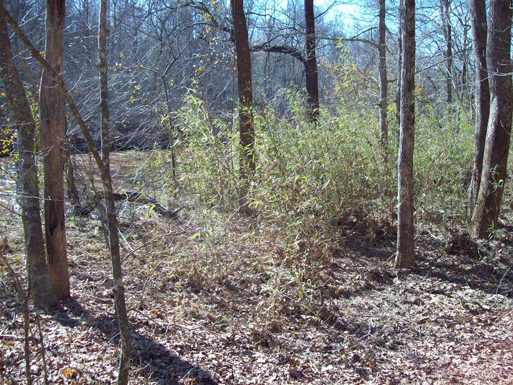The loss of the great canebrakes

In February, The LandTrust for Central N.C. contracted with the N.C. Forest Service to conduct a prescribed burn on a portion of the Low Water Bridge Preserve. Approximately 250 acres were included in this burn area, and a main reason for this burn was to promote a particularly interesting species down along the river here – giant river cane.
| Related article: Low Water Bridge recreational access improvements |
Giant river cane (Arundinaria gigantean) is found in the southeastern United States,and is in the same genus as bamboo. Nonnative bamboo, however, is an invasive species and once established can take over, whereas our native rivercane ecosystem has been drastically reduced in size and area from what it once was historically. The southeastern United States has experienced a loss of cane habitat similar to that of longleaf pine – it’s been estimated that more than 98 percent of all large canebrakes (areas of dense cane growth) here have been lost since the time of settlement. Cane is an important ecosystem that aids in preserving water quality and provides habitat for a variety of wildlife species.
Giant river cane can grow in a variety of habitats, from coastal plain to mountains, on a wide range of soils, and in the understory of both pine and deciduous forests. Historically there were large canebrake expanses along floodplains and in understories as well as on upland slopes. Canebrakes are a natural ecotone, or transition area, between wetland and upland forests.They provide forage, cover and nesting sites for a variety of wildlife. Conversion of lands to agriculture, land clearing and fire suppression has resulted in large losses of this habitat. Canebrakes are now considered a critically endangered ecosystem.
Canebrakes are an early-successional habitat that is maintained by fire, so without fire they transition to forest. In the southeastern United States frequent summer thunderstorms are a natural cause of fires. Native Americans were thought to have conducted prescribed burns to encourage its growth. They used cane for making structures or fences, weaving baskets, making musical instruments and jewelry. Suppression of fire in these areas in recent times has reduced cane density and health.
 When a fire occurs, the stems and leaves are killed, but the rhizomes below the surface survive. The fire stimulates new growth and reduces competition, as other less hearty species are not able to survive. Cane sprouts immediately after a fire and can grow fast, as much as 1.5 inches in 24 hours. Although cane restoration and enhancement has not been well studied, it is suggested that prescribed burns be done on a long rotation to give cane time to recover. A 10-year interval between burns is the general consensus.
When a fire occurs, the stems and leaves are killed, but the rhizomes below the surface survive. The fire stimulates new growth and reduces competition, as other less hearty species are not able to survive. Cane sprouts immediately after a fire and can grow fast, as much as 1.5 inches in 24 hours. Although cane restoration and enhancement has not been well studied, it is suggested that prescribed burns be done on a long rotation to give cane time to recover. A 10-year interval between burns is the general consensus.
Canebrake ecosystems are ecologically significant as habitat for a variety of wildlife species. Several species that are now extinct were once dependent upon these canebrakes, including Carolina Parakeets and Passenger pigeons. There are at least six species of lepidoptera (moths and butterflies) that feed exclusively on river cane. These include the creole pearly eye, southern pearly eye, southern swamp skipper, cobweb little skipper, cane little skipper, and the yellow little skipper. Mammals use river cane habitats too, including “swamp rabbits” and black bears. Wildlife biologists only recently documented Swainsons warblers, which are uncommon now, along the Pee Dee River, and those birds also utilize cane thickets for cover and forage. Another migratory bird species, the Bachman’s warbler, which nested almost exclusively in cane habitat, are now presumed to be extinct. Every time I visit the cane bottomland on our property, I flush a woodcock or two.
The burn at the Low Water Bridge Preserve was made possible by funds available through the Stevens Amendment, which provides funding for prescribed burns on properties within three miles of National Forest lands. The goal of this is to reduce fuel loads to prevent damaging wildfires. This saves time, money and possibly lives by preventing wildfires. Experts who are trained and certified to do prescribed burns carry them out under very specific weather conditions, with good firebreaks and lots of preparation. To learn more, contact the N.C. Forest Service office.